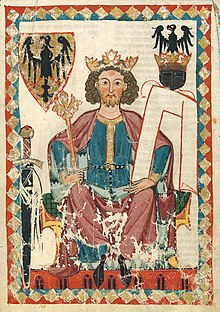Erfurt latrine disaster
You can help expand this article with text translated from the corresponding article in German. (December 2022) Click [show] for important translation instructions.
|
| Native name | Erfurter Latrinensturz |
|---|---|
| Date | 26 July 1184 |
| Venue | Erfurt Cathedral provostry |
| Location | Erfurt, Mainz Electorate, Holy Roman Empire |
| Cause | Floor collapse due to excessive load |
| Deaths | ~60 |

On 26 July 1184, Henry VI, King of Germany (later Holy Roman Emperor), held a Hoftag (informal assembly) at the cathedral provostry in Erfurt during a campaign against the Poles. The combined weight of the assembled nobles caused the wooden second storey floor of the building to collapse. Most of the attendants fell through into the latrine cesspit below the ground floor, where about 60 of them drowned in liquid excrement. This event is called the Erfurter Latrinensturz (lit. 'Erfurt latrine fall') in several German sources.[1][2][3]
Background
[edit]A feud between Landgrave Louis III of Thuringia and Archbishop Conrad of Mainz, which had existed since the defeat of Henry the Lion, intensified to the point that King Henry VI was forced to intervene while he was traveling through the region during a military campaign against Poland. Henry decided to call a diet in Erfurt, where he was staying, to mediate the situation between the two, and invited a number of other figures to the negotiations.[4]
Event
[edit]All of the nobles across the Holy Roman Empire were invited to the meeting, and many arrived on 25 July to attend.[5] Just as the assembly began, the wooden floor of the deanery, in which the nobles were sitting, broke under the stress, and people fell down through the first floor into the latrine in the cellar. About 60 people are said to have died,[6] including Count Gozmar III of Ziegenhain, Count Friedrich I of Abenberg, Burgrave Friedrich I of Kirchberg, Count Heinrich I of Schwarzburg, Count Burgrave Burchard von Wartburg, Count Hansteiner of Liechtenstein and Beringer von Wellingen.[7][8]
King Henry was said to have survived only because he sat in an alcove with a stone floor[5] and was later saved using ladders. He departed as soon as possible. Landgrave Louis III of Thuringia survived as well.[5]
Original texts
[edit]- Cronica Reinhardsbrunnensis, MGH. SS XXX/1, p. 541-542. (in Latin)
- Cronica S. Petri Erfordensis moderna, MGH. SS XXX/1, p. 374. (in original Latin)
- Chronik von St. Peter zu Erfurt (In German translation)
References
[edit]- ^ "Curio #1: The Erfurter Latrinensturz". The Fortweekly. April 2008. Archived from the original on 3 September 2019.
- ^ Magnusson, Roberta J. (1 April 2003). Water Technology in the Middle Ages: Cities, Monasteries, and Waterworks after the Roman Empire. JHU Press. p. 155. ISBN 978-0-8018-7283-9.
- ^ Arnold, Benjamin (29 January 2004). Princes and Territories in Medieval Germany. Cambridge University Press. p. 77. ISBN 978-0-521-52148-2.
- ^ Rundfunk, Bayerischer (26 July 2011). "26. Juli 1184 : Erfurter Latrinensturz". Bayerischer Rundfunk (in German). Archived from the original on 3 September 2019. Retrieved 3 September 2019.
- ^ a b c "RI IV,2,4 n. 2778, Friedrich I., 1184 Juli 25–26, Erfurt : Regesta Imperii". www.regesta-imperii.de (in German). Archived from the original on 21 March 2020. Retrieved 3 September 2019.
- ^ Schwiebert, Ernest George (1996). The Reformation. Fortress Press. p. 100. ISBN 978-0-8006-2836-9.
- ^ Chronik von Sanct Peter zu Erfurt, 1100-1215 (in German). Erfurt abbey of st. Peter. 1881. Archived from the original on 4 October 2010.
- ^ "Geschichte Thüringens zur Zeit des ersten Landgrafenhauses" (in German). Archived from the original on 7 October 2024.
